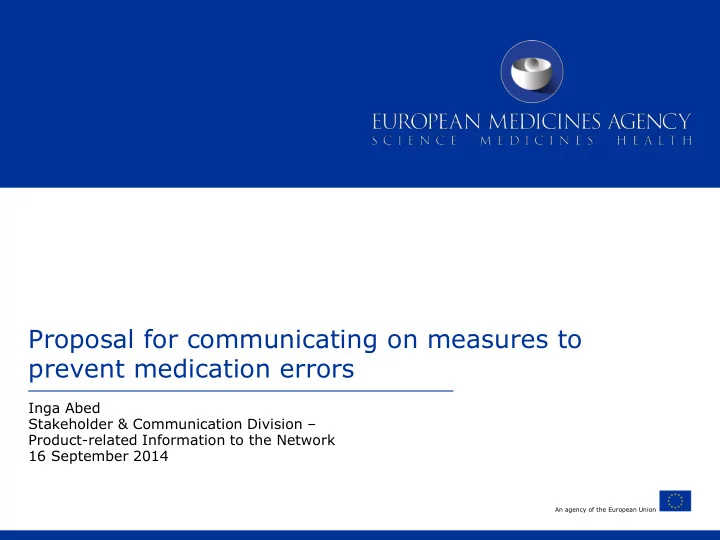

Proposal for communicating on measures to prevent medication errors Inga Abed Stakeholder & Communication Division – Product-related Information to the Network 16 September 2014 An agency of the European Union
What is a medication error – examples • 3 patients died due to the cancer medicine Velcade accidentally being given intrathecally instead of by the intended intravenous route. • Reconstitution errors with the cancer medicine Jevtana have led to overdoses that were 15 % to 20% higher than the prescribed dose. 1
2
What is a medication error • “any unintended error in the prescribing, dispensing or administration of a medicinal product while in the control of the healthcare professional or patient.” • 4 categories: wrong medication, wrong dose (including strength, formulation, amount), wrong route of administration, wrong patient • Can lead to adverse drug reactions with negative outcomes for patients and significant financial cost implications to healthcare systems. 3
The impact of medication errors • Medication-error rates in EU: o Ambulatory care : 7.5% at prescription, 0.08% at dispensing o Hospital care : 0.3 – 9.1% at prescription, 1.6 – 2.1% at dispensing • Major public-health burden - estimated annual cost: 4.5 - 21.8 billion € (World Alliance for Patient Safety 2010) • 18.7 - 56% of all adverse drug events among hospital patients result from medication errors that would be preventable 4
Medication errors are preventable All parts of healthcare system have important role to play in • preventing medications errors. In EU, assessment of a medicine’s potential to cause a • medication errors is part of marketing authorisation evaluation This includes measures to reduce risk: routine or additional. • 5
Routine risk minimisation Routine risk minimisation involves the use of the following tools: • the summary of product characteristics (SmPC) • the package leaflet • the labelling • the pack size and design • the legal (prescription) status of the product 6
Additional risk minimisation measures • educational programme; • controlled access programme; • other risk minimisation measures such as patient alert cards; alerts on/in the packaging; pregnancy prevention programme and DHPCs. 7
Importance of reporting medication errors • medication errors may still occur • In order to further prevent them – reporting is essential • Medication errors go often unreported especially if there is no harm associated. 8
Strengthened safety monitoring with pharmacovigilance legislation • Medication errors now included in the definition of a reportable adverse drug reaction • Now adverse drug reactions resulting from medication errors at EU level to be reported. • Pharmacovigilance and Risk Assessment Committee (PRAC) - dedicated committee 9
Communication • Key in tackling medication errors • Increasing proactive and effective communication at EMA on medication errors is expected to: o increase public awareness and recognition of medication errors; o contribute to the safe use of medicines; o promote the reporting, discussion, understanding and prevention of medication errors ; 10
EMA communication practice • Review of EMA communication practice on medication errors following recent cases, medication errors workshop and other initiatives around medication errors 11
Current communication practice • No consistent communication on medication errors in the past • Q&A in case of medication errors with Velcade • No communication for Macugen 12
Rationale for communicating on medication errors Part of safety communication fulfilling the objectives of • pharmacovigilance EMA communication is additional source of information and • complementary to other communication tools (DHPCs) Considering patients’ role in preventing MEs there is an • argument for increasing public awareness Requested by HCPs in this field • 13
Proposal Routinely communicate when: • additional risk minimisation measures are recommended by EMA to reduce risk of medication error; or a DHPC has been agreed at EU level Communication in format of existing • safety communication 14
Examples for communication • Included in pack • Format similar to other safety communication: General description of error and measures to prevent future errors Dedicated section with recommendations to patients and HCPs 15
16
17
Preparation & Publication • To be implemented shortly; currently working on mock-up communication and webpage • Preparation with involvement of scientific committees, healthcare professional and patient organisations (HCPs/PCOs) • Dissemination to HCPs and PCOs directly and/or through newsletter • Public health communication linked to the EPAR page • Dedicated webpage with listing of communications as well as general information on Agency’s activities regarding prevention of medication errors 18
Conclusion New legal provisions and strengthened European safety • monitoring system medication errors to reduce the risk of medication errors In addition, streamlining communication at EMA on measures • agreed to prevent medication errors: As part of routine safety communication Expected to contribute to the safe use of medicines by increasing awareness 19
Recommend
More recommend